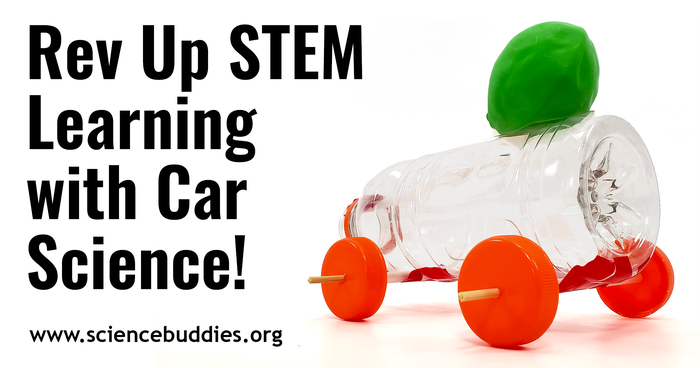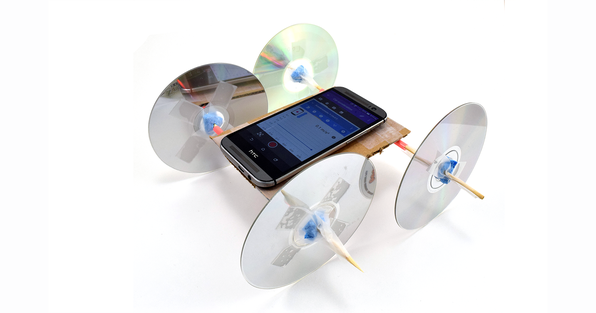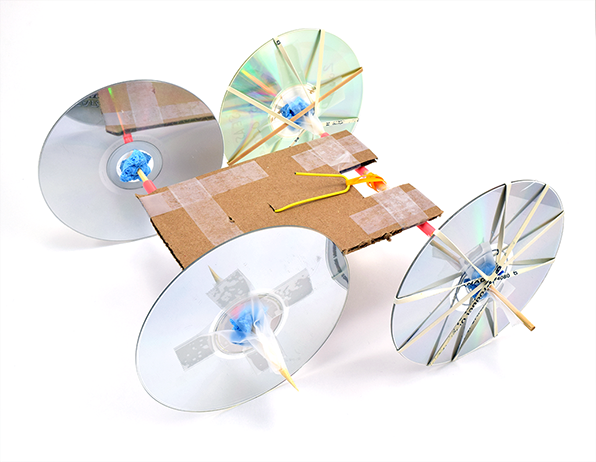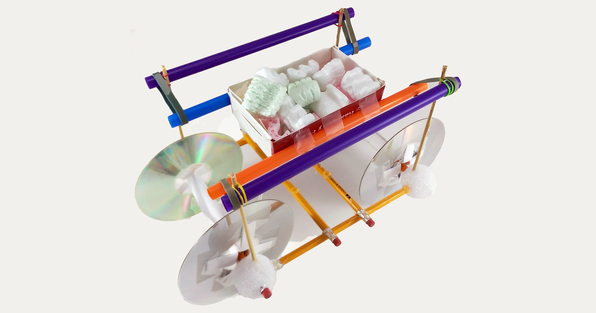Rev Up STEM Learning with Car Science Projects
Use these free STEM lessons, experiments, and activities to teach science and engineering related to cars and to explore core science concepts with homemade cars.

Rev Up STEM Learning — Car Science Experiments for Science Class and Science Fair
Educators can use DIY cars made from simple materials to teach students about science and engineering related to the design, building, testing, and safety of cars and to demonstrate and explore general science concepts in K-12 classrooms.
Homemade cars open up a wide range of science questions your students can investigate with hands-on science and engineering projects. From questions related to the engineering and design of actual cars and car systems to using homemade cars to investigate other science concepts, making simple cars gives STEM learning extra gas. Use the lessons, projects, and activities below to teach about physics and electronics; potential and kinetic energy; Newton's laws of motion and forces of motion; alternative energy and power; engineering design; autonomous vehicles; braking, gears, and differentials; and more.
This resource contains experiments that teach about car science and activities that use DIY cars to help teach about other science concepts. The resources have been grouped as follows:
- Demonstrating Science Concepts with Simple DIY Cars
- Exploring Car Systems with DIY Cars
- Machine Learning and Self-Driving Cars
At the bottom of this resource, you will find related STEM careers for students who are interested in engineering and automotive manufacturing, a list of key vocabulary words, and additional related resources. For students looking for science projects, we have also included a list of independent science and science fair projects.
Note: Science Buddies Lesson Plans contain materials to support educators leading hands-on STEM learning with students. Lesson Plans offer NGSS alignment, contain background materials to boost teacher confidence, even in areas that may be new to them, and include supplemental resources like worksheets, videos, discussion questions, and assessment materials. Activities are simplified explorations that can be used in the classroom or in informal learning environments.
Resources for STEM Learning with DIY Cars
Demonstrating Science Concepts with Simple DIY Cars
Simple cars made from craft and recycled materials, including cardboard, compact discs, balloons, rubber bands, straws, plastic lids, and more, can be great tactile models to use for science experiments. With DIY cars, students can explore potential and kinetic energy, forces of motion, Newton's laws of motion, and other science curriculum. Even as they use their cars to investigate science concepts, students will also need to use engineering design skills to adjust and troubleshoot their cars for maximum performance. They may need to examine the role and function of the axles, the position of the wheels, and the importance of balance in a car's design.
Tip: Are you struggling to make the connection between cardboard cars and real cars? How do balloon- and rubber band-powered cars relate to real-world cars that use gasoline? With these DIY cars, a source of potential energy is used to store energy that will be converted to kinetic energy to move the car. In a real car, gasoline (or battery power) is converted to kinetic energy for the same purpose.
1. Potential and Kinetic Energy with Balloon Cars
In the Balloon Car Lesson Plan lesson, students design and build simple cars to explore potential and kinetic energy. Blowing up the balloon stores potential energy in the balloon. What happens to the energy when the air in the balloon is released? What happens to the car? In addition to investigating potential and kinetic energy, students can use the engineering design process to design and build their car. What design choices might make the car travel farther or faster? (Simplified directions are also available in the Build a Balloon Car activity.)
Note: The 2015 Fluor Engineering Challenge was the Balloon Car Challenge! Take a look at some of the balloon-powered cars students around the world built to get inspired about what your students might do with this hands-on STEM lesson. For students doing independent science fair projects, see: Balloon-Powered Car Challenge.
2. Newton's Second Law of Motion with Simple DIY Cars
In the Push Harder — Newton's Second Law lesson, students use simple cars made from craft and recycled materials to explore the relationship between force, mass, and acceleration. Using their homemade cars, students investigate Newton's second law of motion and observe firsthand that changes in an object's motion are related to both the mass of the object and the sum of the forces acting on the object. Directions are provided for using a mobile app to make real-time observations.

3. Physics with Wind Cars
In the Build a Wind-Powered Car activity, students design and build simple wind-powered cars that roll when placed in front of a fan or strong wind source. In addition to asking questions about how the design of the sail, including its size and shape, relates to the car's movement, students will also need to consider car design essentials related to the placement of the axles and wheels.
4. Potential and Kinetic Energy with Rubber Band Cars
In the Build a Rubber Band-Powered Car activity, students make cars that get their power when a wound rubber band is released. Winding the car's axle stores potential energy from the rubber band. When the rubber band is released, the energy is converted to kinetic energy, and the car is propelled forward. The system is simple, but students will need to pay attention to the design of their cars to make sure the car rolls smoothly.

5. Solar Energy and Junior Solar Sprint
In the Solar-Powered Cars for Junior Solar Sprints lesson, students learn about solar power while also building a solar-powered car and racing it. As part of the engineering design process involved in building their cars, students will need to make decisions about gears and gear ratios. How will these decisions affect the speed of the car? Students may also find that they need to adjust the angle of the solar panel for optimum performance.
Note: Junior Solar Sprint is a program of the Army Education Outreach Program (AEOP). Each year, students compete in the challenge in classrooms and communities. Some teams go on to compete at regional and national events. Get inspired by this story about classrooms and programs that received support from Science Buddies to participate in Junior Solar Sprint in 2019.
Exploring Car Parts and Systems with DIY Cars
When students experiment with homemade cars, they get hands-on with the engineering design process to design, build, test, and iterate. In this process, they explore the skills used in a range of automotive and engineering careers. By changing design features and testing and comparing different models of their DIY cars, students can ask and investigate a number of STEM questions, make changes to improve their cars, observe the importance of iteration in the engineering design process, and learn more about how cars are built and what goes into making cars run efficiently and safely.
The video above covers some of the variables that can be changed in a car science project. Every car has four main parts: wheels, axles, chassis, and power source. Students can choose any of these features and develop a science or engineering project around it. For example, what happens when you use different materials for the wheels? What if the wheels are a different size or shape?
6. Build a Differential with K'Nex
In the Build a Differential from K'Nex® activity, students use the K'Nex® toy building system to build a model differential. Part of the driveshaft in a real car, the differential is an important part of a car's design and allows wheels to spin at different speeds, which is necessary for a car to be able to turn. This activity helps demonstrate how a differential works and why it is necessary.
7. A Smoother Ride with a Shock Absorbers
In the Absorb the Shock! activity, students investigate the role of shock absorbers and a suspension system in a car. You might think a road is rough or bumpy, but without shock absorbers, it would be even worse! With this engineering design activity, students see if they can design a suspension system to help keep the "cargo" in the car from being tossed out when the car rolls over bumpy terrain.

8. Gear Ratio and Junior Solar Sprint
In the Solar-Powered Cars for Junior Solar Sprints lesson, students build solar-powered cars and explore alternative energy, but successfully building a Solar Sprint car involves more than just a sunny day. Students design, assemble, and build the circuit for their cars. In the process, they will need to make decisions about gears and gear ratios. How will these decisions affect the speed of the car? Students may also find that they need to adjust the angle of the solar panel for optimum performance. The videos below provide an overview of these features and how they relate to a car's performance.
9. Car Crash Safety
In the Engineering Car Crash Safety with Newton's Third Law lesson, students use the engineering design process to investigate what happens when cars crash — and what physics has to do with it. By adding bumpers to cars, engineers can help reduce damage and improve the outcome when cars are in an accident. In this STEM lesson, students learn about Newton's third law of motion and use what they discover about equal and opposite reaction forces to design and build a bumper to protect a homemade car during a crash. There is plenty of car crashing at hand as students actively explore strategies for minimizing damage to their cars, strategies that relate to the approaches engineers take in designing and improving real cars.
Note: This lesson has been developed to meet NGSS Performance Expectations related to Newton's third law of motion. Guidance is provided in the "Variations" to enable educators to adapt the lesson to teach about Newton's first and second laws of motion or kinetic and potential energy. For additional resources on these topics, see the list of thematic resource collections at the bottom of this page.
Machine Learning and Self-Driving Cars
Autonomous vehicles are already becoming a familiar part of roadways. You can explore the concept of self-driving cars and the technologies being used to train them with projects and activities that have been specifically developed for use with K-12 students.
10. Self-Driving Cars
What is involved in designing, building, and training autonomous vehicles? What is machine learning, and how is it used in testing and training self-driving cars? What will it take for consumers to trust these vehicles on the road? How might these technologies improve road safety? What are the challenges? As more and more autonomous vehicles begin appearing on roads, there are all kinds of questions to be asked and explored. We have science projects to help students dive in and experiment with the science and technology related to this rapidly evolving field of autonomous vehicles. Topics include the use of sensors, automatic braking, machine learning, and more. See the Explore the Science Behind Self-Driving Cars resource collection for specific projects and activities.
Have Fun with Car Science!
Whether students are doing science projects following the scientific method or brainstorming, prototyping, and testing innovative solutions using the engineering design process, there are exciting STEM questions that can be put to a simulated road test.
Projects for Students Doing Independent Science Projects or Science Fair
Students interested in car science, automotive engineering, and cutting-edge topics like self-driving cars and machine learning can explore with independent projects like these:
- Balloon-Powered Car Challenge
- Build an 'Impossible' Wind-Powered Car
- Build a Miniature Self-Driving Car
- Build a Solar-Powered Car
- Drive a Race Car with Machine Learning
- How Fast is Automatic Braking?
- Identify Road Signs with Machine Learning
- The Speed of Light: Explore Solar Energy with a Supercapacitor Car Motor!
- What Sensors Are Best for Self-Driving Cars?
Career Paths Related to Car Science
As students learn about science and engineering related to car science, they can learn more about related STEM career paths with career profiles like:
- Automotive Engineer
- Automotive Technician
- Electrical & Electronics Engineer
- Mechanical Engineer
- Mechanical Engineering Technician
- Advanced Manufacturing Technician
- Welder
Additional Resources
For additional educator resources to teach about car science and the science concepts referenced above, see:
- Teach About Newton's Laws of Motion
- Forces and Laws of Motion Lessons
- 13 Activities and Lessons to Teach Potential and Kinetic Energy
Vocabulary
The following word bank contains words that may be covered when teaching about car science using the lessons and activities in this resource.
- Alternate energy
- Autonomous vehicle
- Axle
- Chassis
- Differential
- Driveshaft
- Engineering design
- Forces of motion
- Gears
- Kinetic energy
- Machine learning
- Newton's laws of motion
- Potential energy
- Renewable energy
- Shock absorber
- Solar power (solar energy)
- Suspension system
- Wheels
Thematic Collections
Collections like this help educators find themed activities in a specific subject area or discover activities and lessons that meet a curriculum need. We hope these collections make it convenient for teachers to browse related lessons and activities. For other collections, see the Teaching Science Units and Thematic Collections lists. We encourage you to browse the complete STEM Activities for Kids and Lesson Plans areas, too. Filters are available to help you narrow your search.
You Might Also Enjoy These Related Posts:
- Plastics and Earth Day - Science Projects
- Arduino Science Projects and Physical Computing
- 10+ Robotics Projects with the BlueBot Kit
- 5 STEM Activities with Marshmallow Peeps
- March Madness Basketball Science Projects: Sports Science Experiments
- Women in STEM! More than 60 Scientists and Engineers for Women's History Month
- Explore Artificial Intelligence and Machine Learning with Student AI Projects
- 10 Reasons to Do the Rubber Band Car Engineering Challenge

















